Business Operations, Accounting, and Team Dynamics at Unilever
VerifiedAdded on 2020/07/23
|10
|1980
|40
Report
AI Summary
This report examines the operational aspects of businesses, focusing on Unilever as a case study. It covers the importance of accounting in evaluating business performance and managing cash flow. The report delves into HR functions, including recruitment, performance appraisal, and training program development, alongside key features of employment legislation. Financial information interpretation using Profit and Loss accounts is also included. Furthermore, the report explores team dynamics, discussing roles within a team, stages of team development (using Tuckman's model), motivational theories (Maslow's and Herzberg's), and different leadership styles. The conclusion emphasizes the significance of these elements for business sustainability and success. The report references various books and journals to support its findings.
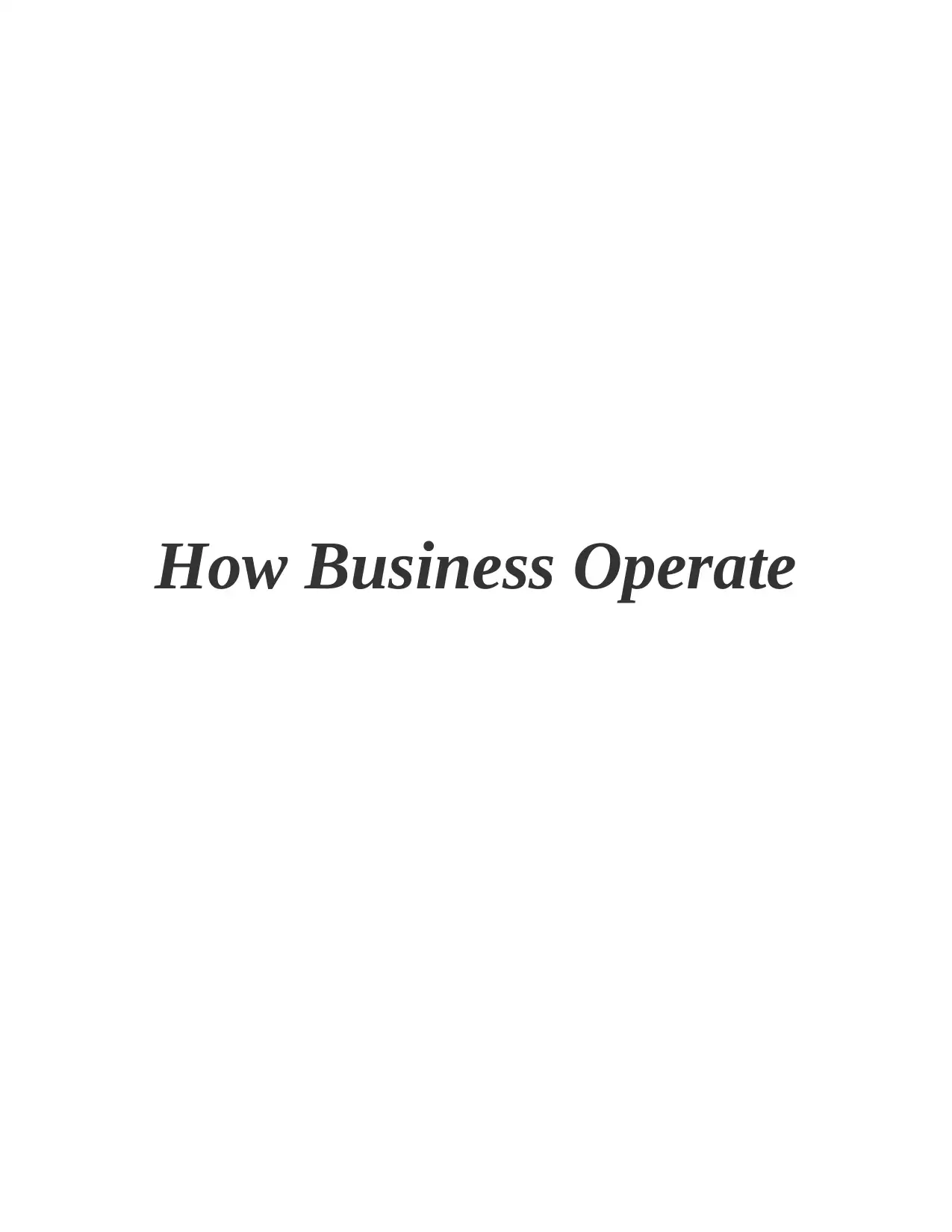
How Business Operate
Paraphrase This Document
Need a fresh take? Get an instant paraphrase of this document with our AI Paraphraser

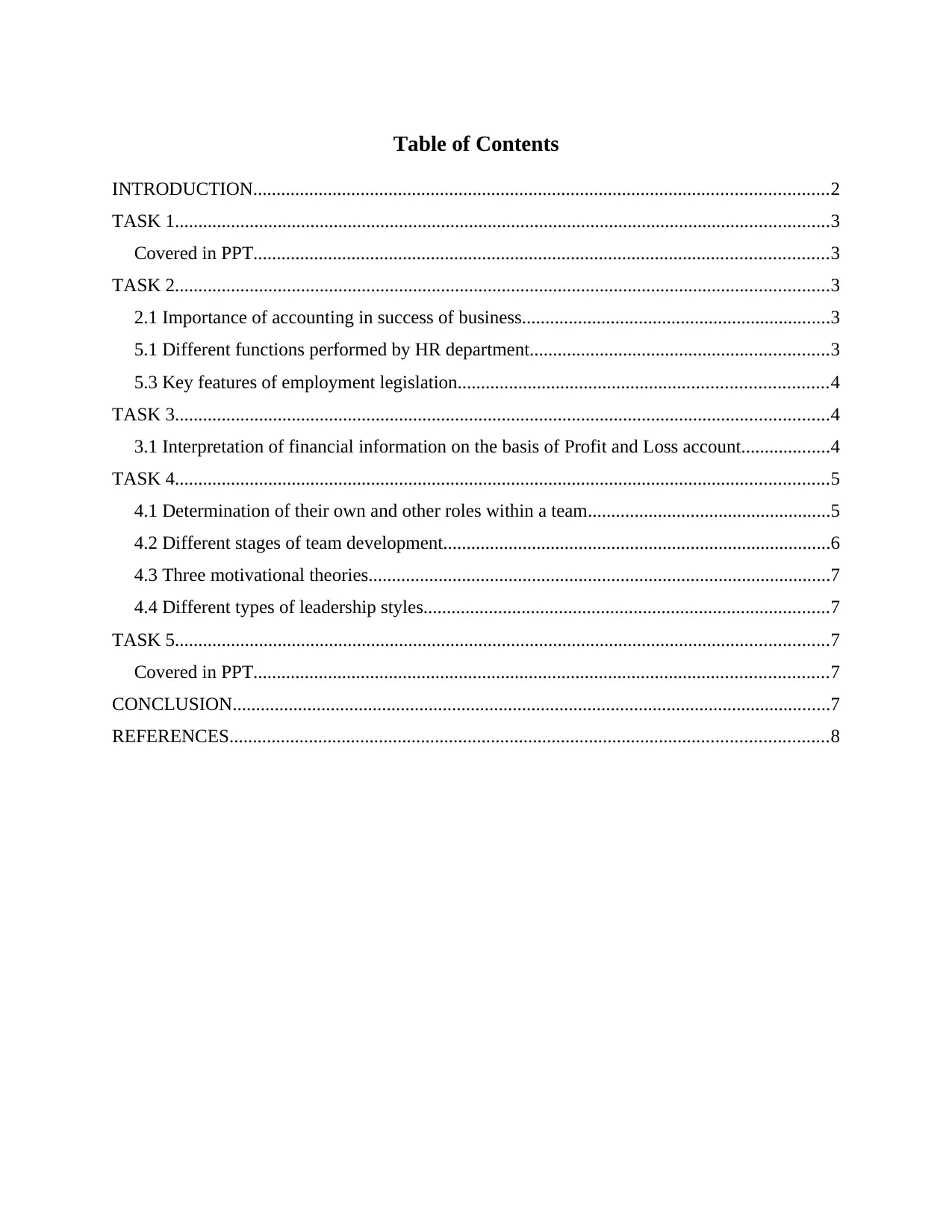
Table of Contents
INTRODUCTION...........................................................................................................................2
TASK 1............................................................................................................................................3
Covered in PPT...........................................................................................................................3
TASK 2............................................................................................................................................3
2.1 Importance of accounting in success of business..................................................................3
5.1 Different functions performed by HR department................................................................3
5.3 Key features of employment legislation...............................................................................4
TASK 3............................................................................................................................................4
3.1 Interpretation of financial information on the basis of Profit and Loss account...................4
TASK 4............................................................................................................................................5
4.1 Determination of their own and other roles within a team....................................................5
4.2 Different stages of team development...................................................................................6
4.3 Three motivational theories...................................................................................................7
4.4 Different types of leadership styles.......................................................................................7
TASK 5............................................................................................................................................7
Covered in PPT...........................................................................................................................7
CONCLUSION................................................................................................................................7
REFERENCES................................................................................................................................8
INTRODUCTION...........................................................................................................................2
TASK 1............................................................................................................................................3
Covered in PPT...........................................................................................................................3
TASK 2............................................................................................................................................3
2.1 Importance of accounting in success of business..................................................................3
5.1 Different functions performed by HR department................................................................3
5.3 Key features of employment legislation...............................................................................4
TASK 3............................................................................................................................................4
3.1 Interpretation of financial information on the basis of Profit and Loss account...................4
TASK 4............................................................................................................................................5
4.1 Determination of their own and other roles within a team....................................................5
4.2 Different stages of team development...................................................................................6
4.3 Three motivational theories...................................................................................................7
4.4 Different types of leadership styles.......................................................................................7
TASK 5............................................................................................................................................7
Covered in PPT...........................................................................................................................7
CONCLUSION................................................................................................................................7
REFERENCES................................................................................................................................8
⊘ This is a preview!⊘
Do you want full access?
Subscribe today to unlock all pages.

Trusted by 1+ million students worldwide
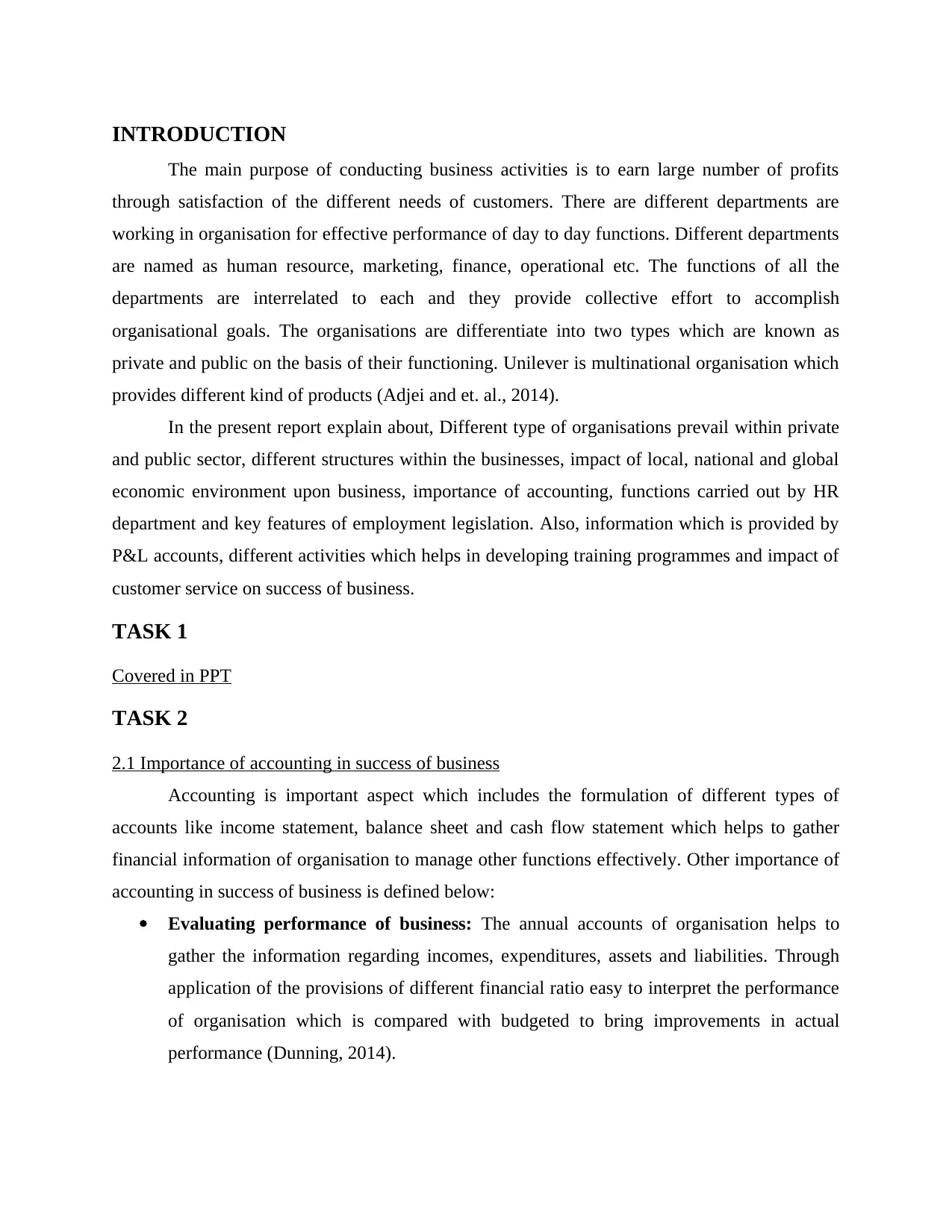
INTRODUCTION
The main purpose of conducting business activities is to earn large number of profits
through satisfaction of the different needs of customers. There are different departments are
working in organisation for effective performance of day to day functions. Different departments
are named as human resource, marketing, finance, operational etc. The functions of all the
departments are interrelated to each and they provide collective effort to accomplish
organisational goals. The organisations are differentiate into two types which are known as
private and public on the basis of their functioning. Unilever is multinational organisation which
provides different kind of products (Adjei and et. al., 2014).
In the present report explain about, Different type of organisations prevail within private
and public sector, different structures within the businesses, impact of local, national and global
economic environment upon business, importance of accounting, functions carried out by HR
department and key features of employment legislation. Also, information which is provided by
P&L accounts, different activities which helps in developing training programmes and impact of
customer service on success of business.
TASK 1
Covered in PPT
TASK 2
2.1 Importance of accounting in success of business
Accounting is important aspect which includes the formulation of different types of
accounts like income statement, balance sheet and cash flow statement which helps to gather
financial information of organisation to manage other functions effectively. Other importance of
accounting in success of business is defined below:
Evaluating performance of business: The annual accounts of organisation helps to
gather the information regarding incomes, expenditures, assets and liabilities. Through
application of the provisions of different financial ratio easy to interpret the performance
of organisation which is compared with budgeted to bring improvements in actual
performance (Dunning, 2014).
The main purpose of conducting business activities is to earn large number of profits
through satisfaction of the different needs of customers. There are different departments are
working in organisation for effective performance of day to day functions. Different departments
are named as human resource, marketing, finance, operational etc. The functions of all the
departments are interrelated to each and they provide collective effort to accomplish
organisational goals. The organisations are differentiate into two types which are known as
private and public on the basis of their functioning. Unilever is multinational organisation which
provides different kind of products (Adjei and et. al., 2014).
In the present report explain about, Different type of organisations prevail within private
and public sector, different structures within the businesses, impact of local, national and global
economic environment upon business, importance of accounting, functions carried out by HR
department and key features of employment legislation. Also, information which is provided by
P&L accounts, different activities which helps in developing training programmes and impact of
customer service on success of business.
TASK 1
Covered in PPT
TASK 2
2.1 Importance of accounting in success of business
Accounting is important aspect which includes the formulation of different types of
accounts like income statement, balance sheet and cash flow statement which helps to gather
financial information of organisation to manage other functions effectively. Other importance of
accounting in success of business is defined below:
Evaluating performance of business: The annual accounts of organisation helps to
gather the information regarding incomes, expenditures, assets and liabilities. Through
application of the provisions of different financial ratio easy to interpret the performance
of organisation which is compared with budgeted to bring improvements in actual
performance (Dunning, 2014).
Paraphrase This Document
Need a fresh take? Get an instant paraphrase of this document with our AI Paraphraser
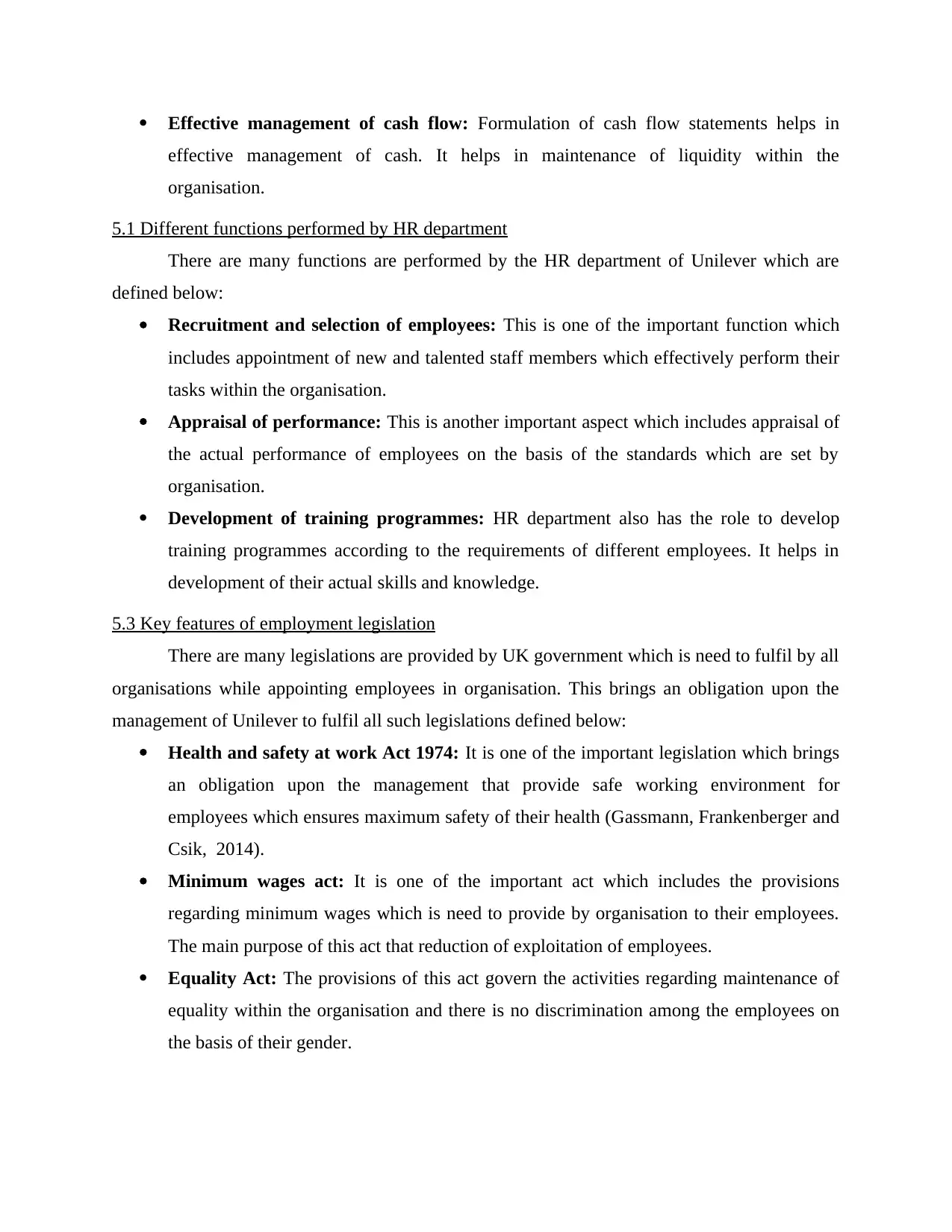
Effective management of cash flow: Formulation of cash flow statements helps in
effective management of cash. It helps in maintenance of liquidity within the
organisation.
5.1 Different functions performed by HR department
There are many functions are performed by the HR department of Unilever which are
defined below:
Recruitment and selection of employees: This is one of the important function which
includes appointment of new and talented staff members which effectively perform their
tasks within the organisation.
Appraisal of performance: This is another important aspect which includes appraisal of
the actual performance of employees on the basis of the standards which are set by
organisation.
Development of training programmes: HR department also has the role to develop
training programmes according to the requirements of different employees. It helps in
development of their actual skills and knowledge.
5.3 Key features of employment legislation
There are many legislations are provided by UK government which is need to fulfil by all
organisations while appointing employees in organisation. This brings an obligation upon the
management of Unilever to fulfil all such legislations defined below:
Health and safety at work Act 1974: It is one of the important legislation which brings
an obligation upon the management that provide safe working environment for
employees which ensures maximum safety of their health (Gassmann, Frankenberger and
Csik, 2014).
Minimum wages act: It is one of the important act which includes the provisions
regarding minimum wages which is need to provide by organisation to their employees.
The main purpose of this act that reduction of exploitation of employees.
Equality Act: The provisions of this act govern the activities regarding maintenance of
equality within the organisation and there is no discrimination among the employees on
the basis of their gender.
effective management of cash. It helps in maintenance of liquidity within the
organisation.
5.1 Different functions performed by HR department
There are many functions are performed by the HR department of Unilever which are
defined below:
Recruitment and selection of employees: This is one of the important function which
includes appointment of new and talented staff members which effectively perform their
tasks within the organisation.
Appraisal of performance: This is another important aspect which includes appraisal of
the actual performance of employees on the basis of the standards which are set by
organisation.
Development of training programmes: HR department also has the role to develop
training programmes according to the requirements of different employees. It helps in
development of their actual skills and knowledge.
5.3 Key features of employment legislation
There are many legislations are provided by UK government which is need to fulfil by all
organisations while appointing employees in organisation. This brings an obligation upon the
management of Unilever to fulfil all such legislations defined below:
Health and safety at work Act 1974: It is one of the important legislation which brings
an obligation upon the management that provide safe working environment for
employees which ensures maximum safety of their health (Gassmann, Frankenberger and
Csik, 2014).
Minimum wages act: It is one of the important act which includes the provisions
regarding minimum wages which is need to provide by organisation to their employees.
The main purpose of this act that reduction of exploitation of employees.
Equality Act: The provisions of this act govern the activities regarding maintenance of
equality within the organisation and there is no discrimination among the employees on
the basis of their gender.
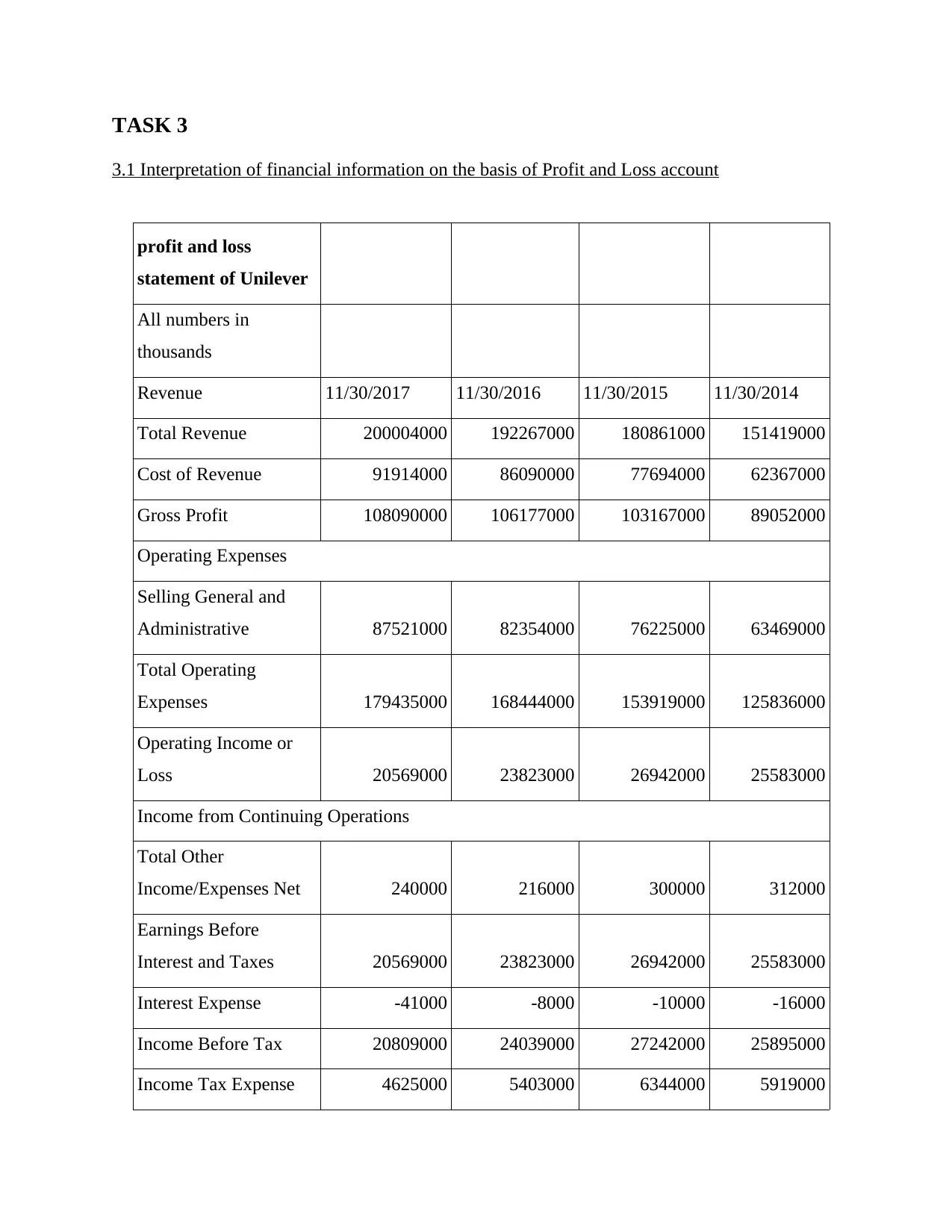
TASK 3
3.1 Interpretation of financial information on the basis of Profit and Loss account
profit and loss
statement of Unilever
All numbers in
thousands
Revenue 11/30/2017 11/30/2016 11/30/2015 11/30/2014
Total Revenue 200004000 192267000 180861000 151419000
Cost of Revenue 91914000 86090000 77694000 62367000
Gross Profit 108090000 106177000 103167000 89052000
Operating Expenses
Selling General and
Administrative 87521000 82354000 76225000 63469000
Total Operating
Expenses 179435000 168444000 153919000 125836000
Operating Income or
Loss 20569000 23823000 26942000 25583000
Income from Continuing Operations
Total Other
Income/Expenses Net 240000 216000 300000 312000
Earnings Before
Interest and Taxes 20569000 23823000 26942000 25583000
Interest Expense -41000 -8000 -10000 -16000
Income Before Tax 20809000 24039000 27242000 25895000
Income Tax Expense 4625000 5403000 6344000 5919000
3.1 Interpretation of financial information on the basis of Profit and Loss account
profit and loss
statement of Unilever
All numbers in
thousands
Revenue 11/30/2017 11/30/2016 11/30/2015 11/30/2014
Total Revenue 200004000 192267000 180861000 151419000
Cost of Revenue 91914000 86090000 77694000 62367000
Gross Profit 108090000 106177000 103167000 89052000
Operating Expenses
Selling General and
Administrative 87521000 82354000 76225000 63469000
Total Operating
Expenses 179435000 168444000 153919000 125836000
Operating Income or
Loss 20569000 23823000 26942000 25583000
Income from Continuing Operations
Total Other
Income/Expenses Net 240000 216000 300000 312000
Earnings Before
Interest and Taxes 20569000 23823000 26942000 25583000
Interest Expense -41000 -8000 -10000 -16000
Income Before Tax 20809000 24039000 27242000 25895000
Income Tax Expense 4625000 5403000 6344000 5919000
⊘ This is a preview!⊘
Do you want full access?
Subscribe today to unlock all pages.

Trusted by 1+ million students worldwide
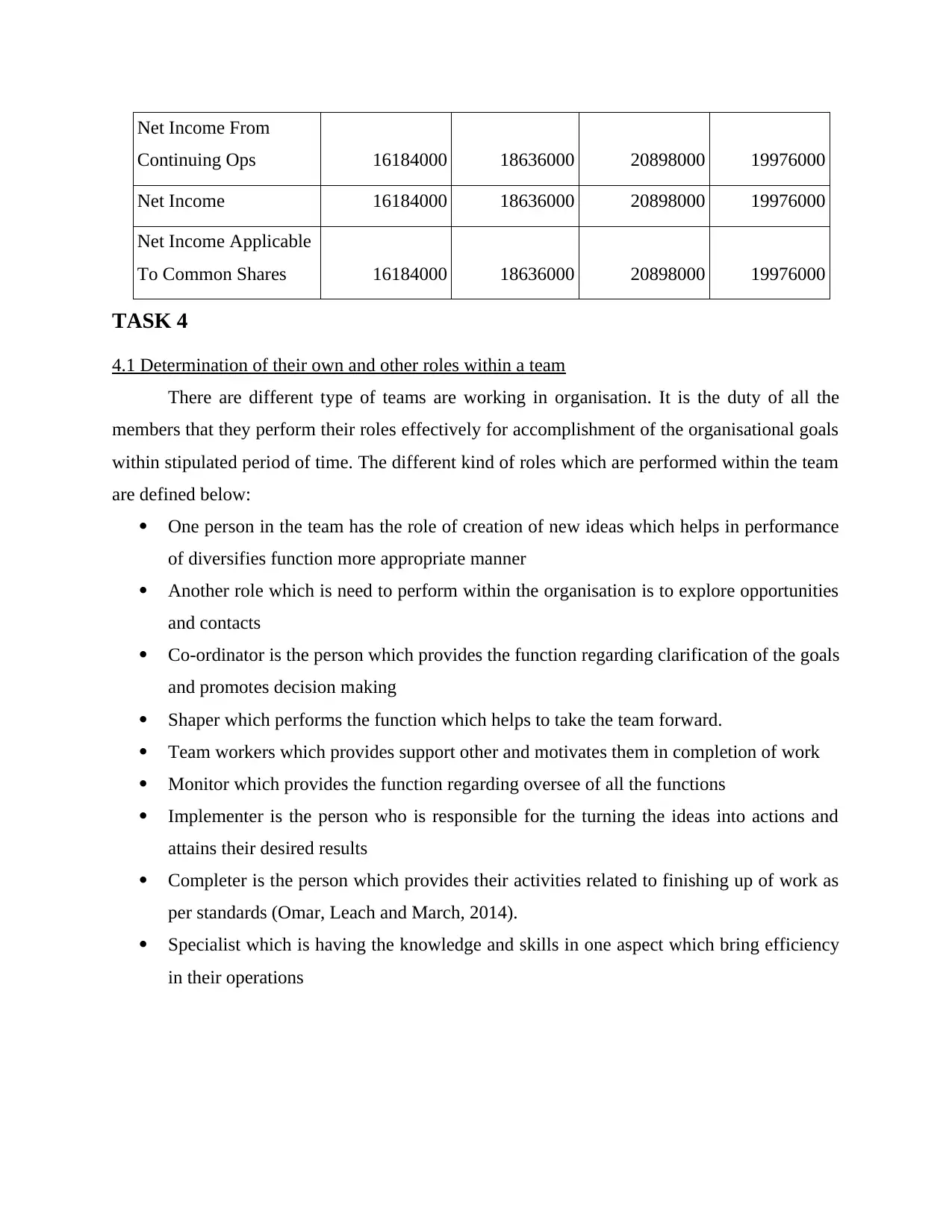
Net Income From
Continuing Ops 16184000 18636000 20898000 19976000
Net Income 16184000 18636000 20898000 19976000
Net Income Applicable
To Common Shares 16184000 18636000 20898000 19976000
TASK 4
4.1 Determination of their own and other roles within a team
There are different type of teams are working in organisation. It is the duty of all the
members that they perform their roles effectively for accomplishment of the organisational goals
within stipulated period of time. The different kind of roles which are performed within the team
are defined below:
One person in the team has the role of creation of new ideas which helps in performance
of diversifies function more appropriate manner
Another role which is need to perform within the organisation is to explore opportunities
and contacts
Co-ordinator is the person which provides the function regarding clarification of the goals
and promotes decision making
Shaper which performs the function which helps to take the team forward.
Team workers which provides support other and motivates them in completion of work
Monitor which provides the function regarding oversee of all the functions
Implementer is the person who is responsible for the turning the ideas into actions and
attains their desired results
Completer is the person which provides their activities related to finishing up of work as
per standards (Omar, Leach and March, 2014).
Specialist which is having the knowledge and skills in one aspect which bring efficiency
in their operations
Continuing Ops 16184000 18636000 20898000 19976000
Net Income 16184000 18636000 20898000 19976000
Net Income Applicable
To Common Shares 16184000 18636000 20898000 19976000
TASK 4
4.1 Determination of their own and other roles within a team
There are different type of teams are working in organisation. It is the duty of all the
members that they perform their roles effectively for accomplishment of the organisational goals
within stipulated period of time. The different kind of roles which are performed within the team
are defined below:
One person in the team has the role of creation of new ideas which helps in performance
of diversifies function more appropriate manner
Another role which is need to perform within the organisation is to explore opportunities
and contacts
Co-ordinator is the person which provides the function regarding clarification of the goals
and promotes decision making
Shaper which performs the function which helps to take the team forward.
Team workers which provides support other and motivates them in completion of work
Monitor which provides the function regarding oversee of all the functions
Implementer is the person who is responsible for the turning the ideas into actions and
attains their desired results
Completer is the person which provides their activities related to finishing up of work as
per standards (Omar, Leach and March, 2014).
Specialist which is having the knowledge and skills in one aspect which bring efficiency
in their operations
Paraphrase This Document
Need a fresh take? Get an instant paraphrase of this document with our AI Paraphraser
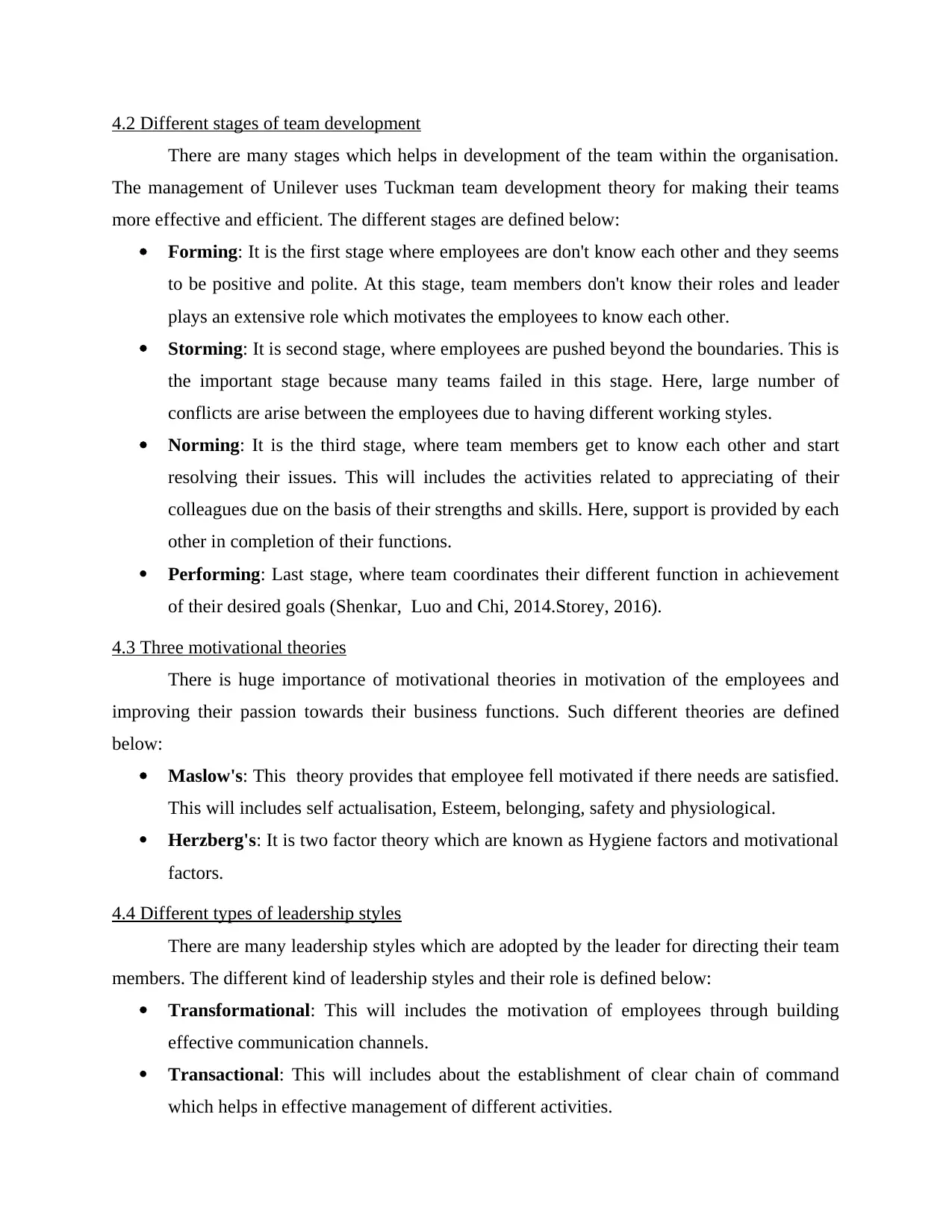
4.2 Different stages of team development
There are many stages which helps in development of the team within the organisation.
The management of Unilever uses Tuckman team development theory for making their teams
more effective and efficient. The different stages are defined below:
Forming: It is the first stage where employees are don't know each other and they seems
to be positive and polite. At this stage, team members don't know their roles and leader
plays an extensive role which motivates the employees to know each other.
Storming: It is second stage, where employees are pushed beyond the boundaries. This is
the important stage because many teams failed in this stage. Here, large number of
conflicts are arise between the employees due to having different working styles.
Norming: It is the third stage, where team members get to know each other and start
resolving their issues. This will includes the activities related to appreciating of their
colleagues due on the basis of their strengths and skills. Here, support is provided by each
other in completion of their functions.
Performing: Last stage, where team coordinates their different function in achievement
of their desired goals (Shenkar, Luo and Chi, 2014.Storey, 2016).
4.3 Three motivational theories
There is huge importance of motivational theories in motivation of the employees and
improving their passion towards their business functions. Such different theories are defined
below:
Maslow's: This theory provides that employee fell motivated if there needs are satisfied.
This will includes self actualisation, Esteem, belonging, safety and physiological.
Herzberg's: It is two factor theory which are known as Hygiene factors and motivational
factors.
4.4 Different types of leadership styles
There are many leadership styles which are adopted by the leader for directing their team
members. The different kind of leadership styles and their role is defined below:
Transformational: This will includes the motivation of employees through building
effective communication channels.
Transactional: This will includes about the establishment of clear chain of command
which helps in effective management of different activities.
There are many stages which helps in development of the team within the organisation.
The management of Unilever uses Tuckman team development theory for making their teams
more effective and efficient. The different stages are defined below:
Forming: It is the first stage where employees are don't know each other and they seems
to be positive and polite. At this stage, team members don't know their roles and leader
plays an extensive role which motivates the employees to know each other.
Storming: It is second stage, where employees are pushed beyond the boundaries. This is
the important stage because many teams failed in this stage. Here, large number of
conflicts are arise between the employees due to having different working styles.
Norming: It is the third stage, where team members get to know each other and start
resolving their issues. This will includes the activities related to appreciating of their
colleagues due on the basis of their strengths and skills. Here, support is provided by each
other in completion of their functions.
Performing: Last stage, where team coordinates their different function in achievement
of their desired goals (Shenkar, Luo and Chi, 2014.Storey, 2016).
4.3 Three motivational theories
There is huge importance of motivational theories in motivation of the employees and
improving their passion towards their business functions. Such different theories are defined
below:
Maslow's: This theory provides that employee fell motivated if there needs are satisfied.
This will includes self actualisation, Esteem, belonging, safety and physiological.
Herzberg's: It is two factor theory which are known as Hygiene factors and motivational
factors.
4.4 Different types of leadership styles
There are many leadership styles which are adopted by the leader for directing their team
members. The different kind of leadership styles and their role is defined below:
Transformational: This will includes the motivation of employees through building
effective communication channels.
Transactional: This will includes about the establishment of clear chain of command
which helps in effective management of different activities.
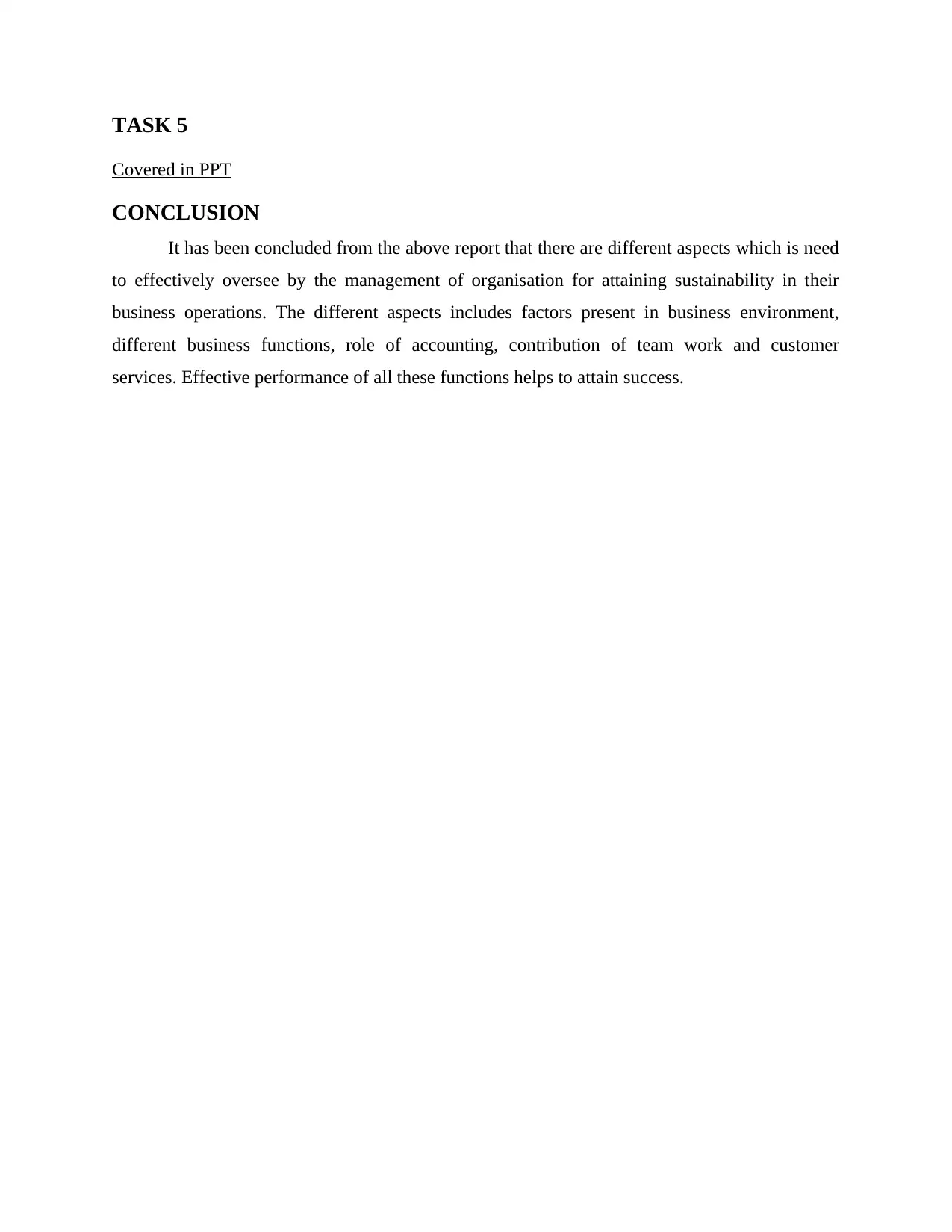
TASK 5
Covered in PPT
CONCLUSION
It has been concluded from the above report that there are different aspects which is need
to effectively oversee by the management of organisation for attaining sustainability in their
business operations. The different aspects includes factors present in business environment,
different business functions, role of accounting, contribution of team work and customer
services. Effective performance of all these functions helps to attain success.
Covered in PPT
CONCLUSION
It has been concluded from the above report that there are different aspects which is need
to effectively oversee by the management of organisation for attaining sustainability in their
business operations. The different aspects includes factors present in business environment,
different business functions, role of accounting, contribution of team work and customer
services. Effective performance of all these functions helps to attain success.
⊘ This is a preview!⊘
Do you want full access?
Subscribe today to unlock all pages.

Trusted by 1+ million students worldwide
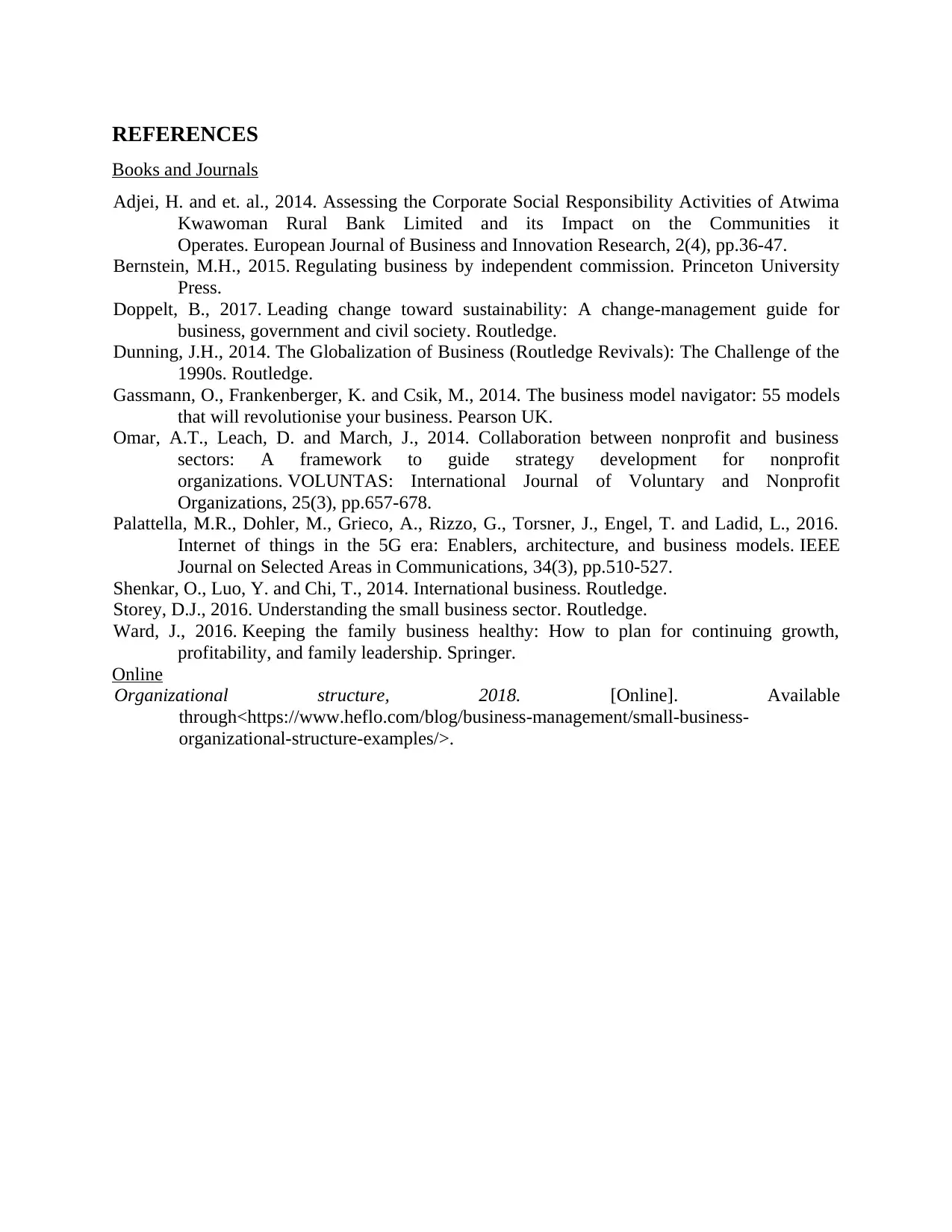
REFERENCES
Books and Journals
Adjei, H. and et. al., 2014. Assessing the Corporate Social Responsibility Activities of Atwima
Kwawoman Rural Bank Limited and its Impact on the Communities it
Operates. European Journal of Business and Innovation Research, 2(4), pp.36-47.
Bernstein, M.H., 2015. Regulating business by independent commission. Princeton University
Press.
Doppelt, B., 2017. Leading change toward sustainability: A change-management guide for
business, government and civil society. Routledge.
Dunning, J.H., 2014. The Globalization of Business (Routledge Revivals): The Challenge of the
1990s. Routledge.
Gassmann, O., Frankenberger, K. and Csik, M., 2014. The business model navigator: 55 models
that will revolutionise your business. Pearson UK.
Omar, A.T., Leach, D. and March, J., 2014. Collaboration between nonprofit and business
sectors: A framework to guide strategy development for nonprofit
organizations. VOLUNTAS: International Journal of Voluntary and Nonprofit
Organizations, 25(3), pp.657-678.
Palattella, M.R., Dohler, M., Grieco, A., Rizzo, G., Torsner, J., Engel, T. and Ladid, L., 2016.
Internet of things in the 5G era: Enablers, architecture, and business models. IEEE
Journal on Selected Areas in Communications, 34(3), pp.510-527.
Shenkar, O., Luo, Y. and Chi, T., 2014. International business. Routledge.
Storey, D.J., 2016. Understanding the small business sector. Routledge.
Ward, J., 2016. Keeping the family business healthy: How to plan for continuing growth,
profitability, and family leadership. Springer.
Online
Organizational structure, 2018. [Online]. Available
through<https://www.heflo.com/blog/business-management/small-business-
organizational-structure-examples/>.
Books and Journals
Adjei, H. and et. al., 2014. Assessing the Corporate Social Responsibility Activities of Atwima
Kwawoman Rural Bank Limited and its Impact on the Communities it
Operates. European Journal of Business and Innovation Research, 2(4), pp.36-47.
Bernstein, M.H., 2015. Regulating business by independent commission. Princeton University
Press.
Doppelt, B., 2017. Leading change toward sustainability: A change-management guide for
business, government and civil society. Routledge.
Dunning, J.H., 2014. The Globalization of Business (Routledge Revivals): The Challenge of the
1990s. Routledge.
Gassmann, O., Frankenberger, K. and Csik, M., 2014. The business model navigator: 55 models
that will revolutionise your business. Pearson UK.
Omar, A.T., Leach, D. and March, J., 2014. Collaboration between nonprofit and business
sectors: A framework to guide strategy development for nonprofit
organizations. VOLUNTAS: International Journal of Voluntary and Nonprofit
Organizations, 25(3), pp.657-678.
Palattella, M.R., Dohler, M., Grieco, A., Rizzo, G., Torsner, J., Engel, T. and Ladid, L., 2016.
Internet of things in the 5G era: Enablers, architecture, and business models. IEEE
Journal on Selected Areas in Communications, 34(3), pp.510-527.
Shenkar, O., Luo, Y. and Chi, T., 2014. International business. Routledge.
Storey, D.J., 2016. Understanding the small business sector. Routledge.
Ward, J., 2016. Keeping the family business healthy: How to plan for continuing growth,
profitability, and family leadership. Springer.
Online
Organizational structure, 2018. [Online]. Available
through<https://www.heflo.com/blog/business-management/small-business-
organizational-structure-examples/>.
1 out of 10
Related Documents
Your All-in-One AI-Powered Toolkit for Academic Success.
+13062052269
info@desklib.com
Available 24*7 on WhatsApp / Email
![[object Object]](/_next/static/media/star-bottom.7253800d.svg)
Unlock your academic potential
Copyright © 2020–2025 A2Z Services. All Rights Reserved. Developed and managed by ZUCOL.





